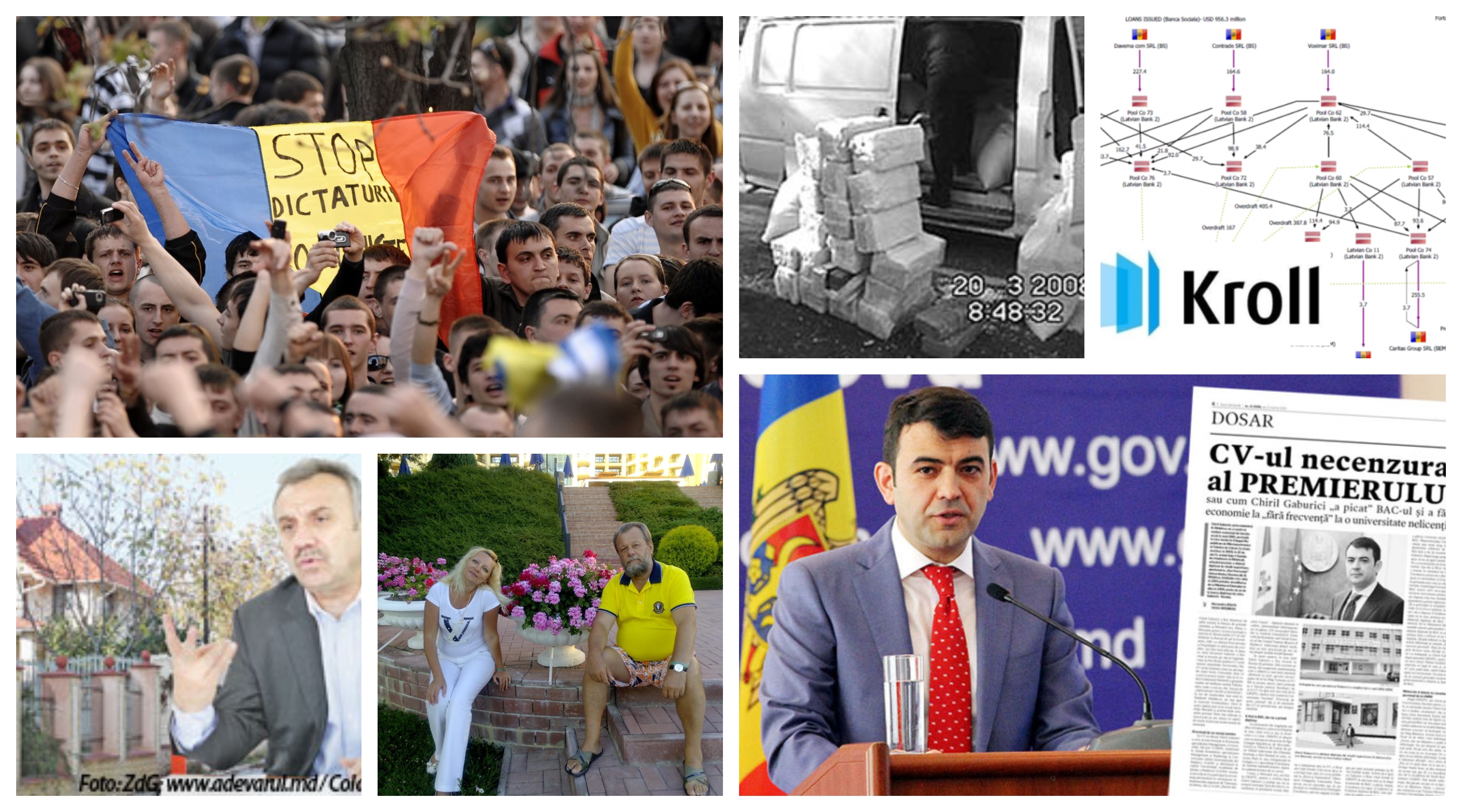April 7, Heroin, a Millionaire Archbishop and More: ZdG’s Top Stories in 15 Years

For the past fifteen years Ziarul de Gardă has been investigating corruption and breaking Moldova’s biggest stories. To celebrate our fifteenth anniversary, we bring you the best of the best in ZdG’ s investigative reporting.
The Heroin Case
On 2 March 2008, two police inspectors found 200 kilos of heroin bricks concealed in a car loaded with bean bags in the center of Chişinău. The driver of the car was Turkish citizen Karalar Murat. The drugs, amounting to 10 million lei (€ 511,000 at the time), were to be taken to a warehouse in Vatra village for further packaging and export.
Ziarul de Gardă was the only media outlet to monitor this case over the last 10 years. During this time, two Turkish citizens as well as four policemen – suspected by prosecutors for protecting the “business” – were arrested, tried, sentenced and/or released.
In July 2018, after 10 years of investigating the Heroin case, Moldova’s Supreme Court closed it. Throughout this period, the case was examined in seven courts, which succeeded in rendering no less than six different rulings, in which the defendants were either acquitted or convicted. Finally, four of the six defendants were irrevocably convicted. Nevertheless, none of them are imprisoned, as they had previously left the territory of the Republic of Moldova.
April 7, 2009
Even if ten years have already passed, the 7 April 2009 events have not been fully elucidated. Throughout this decade, ZdG has published countless articles, interviews, and stories about those who participated in the protest and then became victims of the communist regime which controlled policemen, prosecutors and judges, all of whom became accomplices to the atrocities that took place. In 2017, 8 years since the events, ZdG wrote that dozens of important officials maintained key administrative positions and continued to govern Moldova. Some heads of the police stations in which young people were tortured in April 2009 returned to lead those subdivisions, and some of the judges and prosecutors involved even managed to get promoted. Some of the politicians who were then in power later went on to work side by side with those who were protesting in opposition, shouting “Down with the Communists!” Some communists turned into socialists, and others became democrats, continuing to govern Moldova. Only one April 2009 official, police officer Ion Perju, was charged and sentenced to jail time, but he was never put behind bars because he managed to flee the country before the sentence was pronounced.
Mulțumim că citești ZdG!
Ajută-ne să continuăm să furnizăm informații esențiale — donează pentru jurnalismul nostru.

The Metropolitan Archbishop’s Fortune
In September 2014, ZdG first revealed information about the wealth of Metropolitan Archbishop Vladimir (born Nicolae Cantarean). Through a company he founded, the Metropolitan Archbishop and another member of the clergy was leasing a hectare of forest near the village of Ruseştii Noi, Ialoveni, where he built a holiday home thoroughly protected from the eyes of ordinary people.
The Metropolitan Archbishop also enjoyed the luxury of a Toyota Land Cruiser vehicle, with government number plates. In the same year, ZdG revealed that the Metropolitan Archbishop of Moldova owned an apartment of 175 square meters in the center of Chişinău worth over three million lei (€ 153,000) and was the co-founder of two companies.
Later, ZdG published pictures and information about the multi-million lei house in the countryside, where Metropolitan Archbishop Vladimir lived. It seemed that Nelli Tcaciuc, a woman appearing in several photographs with the Archbishop on the Turkish seaside, was the owner of the building. The Archbishop was often criticized in society, especially for the church’s involvement in politics. In October 2016, in the midst of the presidential electoral campaign, the Archbishop openly declared his support for Socialist Party leader Igor Dodon. At that time, ZdG published a new set of photos from the Archbishop’s luxurious vacation with Nelli Tcaciuc.

The Billion Case
One of the most widely broadcast media topics over the past four years has been the “Billion Case.” ZdG has covered suspicious activities at Moldova’s Banca de Economii (BEM) since 2013. After information about the one billion U.S. dollars stolen from three Moldovan banks (BEM, Banca Sociala and Unibank) was made public, ZdG tackled the subject permanently.
We have written dozens of news pieces and investigative articles about Ilan Shor, the main person figuring in the Kroll company’s audit reports on the “robbery of the century.” We attended the court sessions examining Shor’s case, witnessed the postponement of the sessions and the delay in issuing a final decision until, in the end, we found ourselves reporting that Ilan Shor illegally fled Moldova without serving his sentence.
On 19 July, 2019 Shor did not appear at the last hearing scheduled at Cahul Court of Appeals and the next meeting was scheduled for 25 July. Ilan Shor was sentenced in first hearing to seven years and six months in jail on accounts of fraud and money laundering, but he was released until the decision of the Court of Appeals. On 24 February, Ilan Shor became a deputy after being elected in the Orhei constituency.
We are far from seeing the end of the “billion case.” In the second Kroll report, which was recently made public, new names and firms not listed in the first report appear. At the same time, the new parliamentary majority formed a commission to investigate the theft of the billion. ZdG will continue to monitor the “theft of the century” and keep readers informed.
Chiril Gaburici’ s CV Uncensored
In March 2015, shortly after Chiril Gaburici was appointed Prime Minister, Ziarul de Gardă revealed unknown details from his past in the article “The Prime Minister’s Uncensored CV.” The investigation revealed that while he had studied at the College of Microelectronics and Computer Engineering in Chişinău, he failed to pass the Baccalaureate exams and left without obtaining a secondary school diploma. He then enrolled and was later expelled from the Academy of Economic Studies and finally ended up at the Slavonian University, which at that time was not accredited. Most importantly, it remained unclear what secondary school diploma he used when he enrolled at the university.
The education scandal soon turned into a criminal case, opened under the reasonable suspicion that Gaburici had a fake secondary school diploma. On 12 June 2015, a day after prosecutors had heard him testify in the criminal case on his studies, and three and a half months after ZdG published the article on his “uncensored” CV, Gaburici resigned.
In 2018, when Gaburici returned to the Government, this time as the Minister of Economy, ZdG resumed the investigation. Once again, Gaburici avoided casting light on the authenticity of his studies, refusing to provide answers to ZdG’s questions. At the same time, the Prosecutor’s Office refused to give us access to the file that had already been classified due to the expiry of the prescription period for criminal liability.

Officials, Judges and Prosecutors with Fortunes Worth Millions
Over the past eight years, in almost every newspaper issue, we published an article about the unjustified large assets of deputies, ministers, judges, prosecutors and other state officials. While their official salaries were no larger than several thousand lei, these public officials managed to build extravagant villas, drive luxury cars and go on expensive vacations.
Magistrates of all ranks, ranging from district courts to the Court of Appeals and the Supreme Court came under the close scrutiny of ZdG reporters. In June 2016, we revealed the impressive houses of Supreme Court judges. Mariana Pitic, one of the magistrates who owns an extravagant property, indicated in her personal net wealth statement that the luxury car she drove, a Porsche Cayenne, was bought with only 11,000 lei (€ 562), while the market price of this car in the used market reaches 1 million lei (€ 51,000).
In November 2017, we unveiled the names of several employees of the National Anti-Corruption Center (CNA) who lived in luxury, officially registering their wealth in the name of their relatives. For example, Mihail Cojocaru, at that time a deputy head of a CNA directorate, was driving a BMW worth 1.5 million lei (€ 76,600) and was living in a 150 square meter apartment.
Beggars Unmasked
In April of this year, we entered into the world of the masked beggars. For several months we have documented the work schemes of dozens of beggars, who appeared seriously ill at the first glance, but were healthy in reality. Some of them struggled to move, using either crutches or wheelchairs. Others displayed their braces to obtain sympathy of passers by. To be even more convincing, the beggars invoked God’s name and used religious icons. When we tried to talk with them, most of them became violent and used vulgar language. After ZdG revealed the tricks used by the so called beggars, some of them even disappeared from the streets of Chişinău. Their place was soon taken by others, who, likewise, pretend to be sick to make money. One of the protagonists of the investigation, however, continued to practice begging but moved his operation to Bucharest.
Anatolie Eșanu



